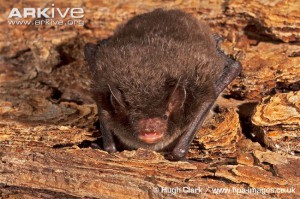Echolocation is type of sensory system in which an animal can generate biosonar signals to detect and locate objects. Hunting bats are one of the mammals that utilize this system in order to locate prey. Daubenton’s bats, Myotis daubentonii, are small to medium-sized bats that live in Europe and some parts of Japan and Korea, where they live in wooded areas within close vicinity of a body of water, such as a river or stream. They are insectivores and tend to hunt just after twilight and into the night. The can produce sounds between 35-85 kHZ, and use calls to locate potential prey.
Because bats have the ability to fly, they have multiple planes in which they can hunt. In a study done by Hugal and Ratcliffe, they divided this potential hunting area into two different “dimensions;’ over water and in the air. Water-trawling is considered a 2-dimensional hunting ground, because all insects the bats would prey on in this environment are located just above the surface of the water, creating one plane for the bats to hunt on. Aerial hunting is considered 3-dimensional hunting because insect prey can travel in any direction.
In this study, Hugal and Ratcliffe investigated the differences in sound duration and its proxy to task difficulty. The researchers then divided the type of biosonar signals emit into two categories; ‘buzz I’ and ‘buzz II.’ Buzz I calls consisted of approximately 90 calls a second at a higher frequency, while buzz II calls were produced around 160 calls a second at a lower frequency. This gives the bats the largest frequency range to detect prey. They tested that the type of call and duration would change depending on the hunting strategy and the amount of attention the task required. They predicted that hunting in a 2D environment would elicit more buzz II, and that buzz I calls would be used to would be used for aerial, moving prey. This is because call sequences of multiple short bursts, increase the amount of information that the bat receives. This gives the bat more and more precise information, the closer it gets to its prey, allowing it to zero in for the kill, especially when the prey target is stationary. Longer calls send a larger stream of signals, allowing for more real-estate to be interrupted. This is more beneficial for moving prey or prey that is at a greater distance.
Their results supported their hypothesis that more difficult tasks, i.e. aerial hunting, would result in longer vocalizations, and greater energy output. This, they suggest, is proxy for how difficult a task is. Closer prey requires shorter signals, and therefore less energy output. As Figure 2A (below) shows, the further away the bat is from the prey, the lower the time interval between vocalizations.

Call (pulse) intervals, attack distances, SSGs, spectrograms and oscillograms for attack sequences. Hulgard, Katrine, Ratcliffe, John M. “Sonar sound groups and increased terminal buzz duration reflect task complexity in hunting bats.” Nature, 2016. 21500 (2016). doi:10.1038/srep21500.
These findings have important implications in understanding how bats’ sensory systems have evolved to make them successful in their environment. Their usage of an array of biosonar vocalizations allows them to detect prey in specific hunting environments, and their selectivity of call type depending on the hunting environment is telling of the complexity of this system and deters previous assumptions that vocalizations were independent of one another. It also demonstrates that bats are able to utilize the information they receive form this type of signaling in real time. Further studies should be done as to how the water reflects signaling back to the bats, and whether the acoustics of water affect the signals.
Hulgard, Katrine, Ratcliffe, John M. “Sonar sound groups and increased terminal buzz duration reflect task complexity in hunting bats.” Nature, 2016. 21500 (2016). doi:10.1038/srep21500.
“Daubenton’s bat.” Wildscreen Arkive. Web 17 Feb. 2016. http://www.arkive.org/daubentons-bat/myotis-daubentonii/

